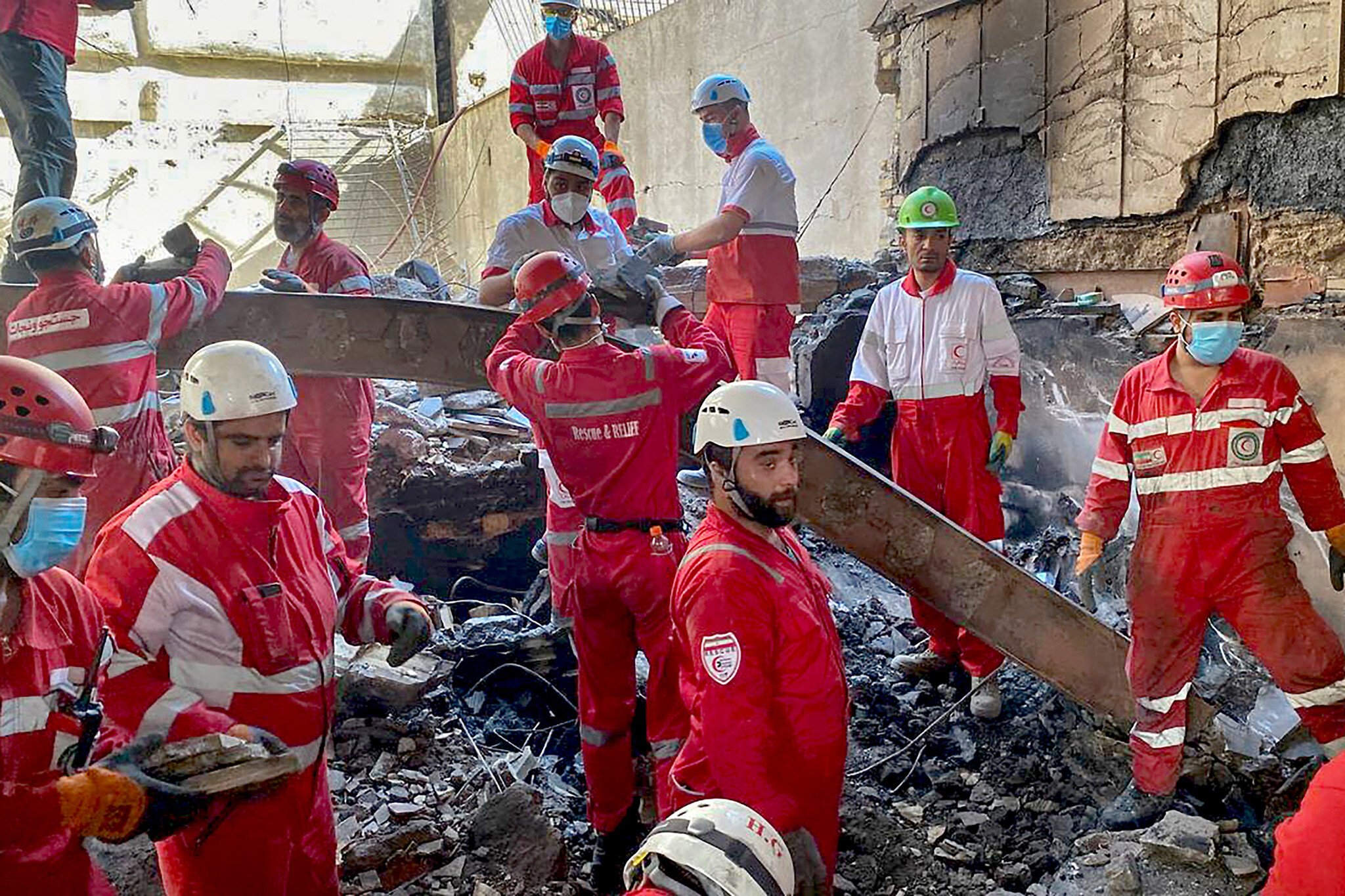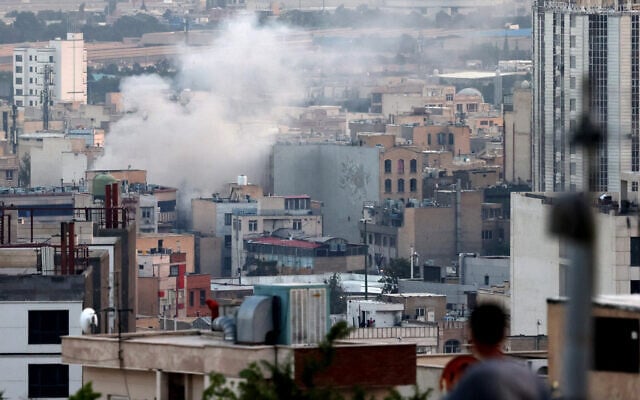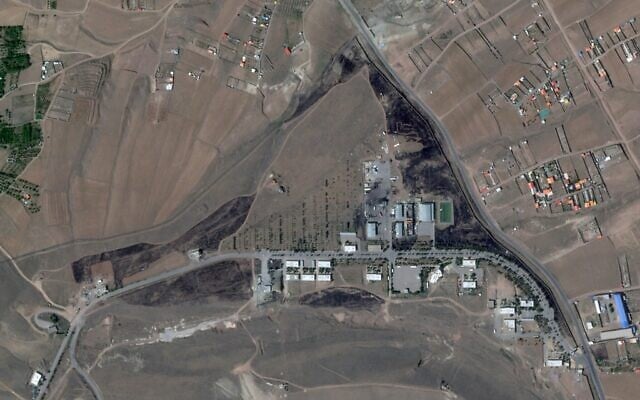



Israel killed a senior Iranian general overnight, just days after eliminating his predecessor, the Israel Defense Forces said Tuesday morning, as the campaign against Iran’s nuclear program and Iran’s retaliatory missile barrages at Israel entered their fifth day.
Israel launched its campaign early Friday, asserting an imminent existential threat from the regime’s nuclear and ballistic missile programs.
Explosions and air defense fire were reported Tuesday in Tehran. Air defenses were reportedly also activated in Natanz, home to a major uranium enrichment plant that was seriously damaged in Israel’s opening attack, and satellite images showed extensive damage at a missile base.
An airstrike Monday night killed Maj. Gen. Ali Shadmani, the new head of the Khatam-al Anbiya Central Headquarters, also known as Iran’s military emergency command. He had only been on the job for some four days, having replaced Maj. Gen. Gholam Ali Rashid, who was killed on Friday in Israel’s opening strikes against Iran.
The IDF said Shadmani was de facto Iran’s most senior military commander, the “war chief of staff,” and was considered the closest remaining military figure to Iran’s Supreme Leader Ali Khamenei.
Shadmani “commanded both the [Islamic Revolutionary Guards Corps] and the Iranian Armed Forces” amid the conflict, the IDF said.
The IDF said that under Shadmani’s command, the Khatam-al Anbiya Central Headquarters “was responsible for managing combat operations and approving Iran’s attack plans.
“In his various roles, he had a direct influence on Iran’s offensive plans targeting the State of Israel,” the military added.
Shadmani previously served as deputy of the Khatam-al Anbiya HQ and as chief of operations in Iran’s armed forces, the IDF said.
Iranian media, meanwhile, reported explosions and heavy air defense fire in Tehran early on Tuesday, with smoke rising in the city’s east after an explosion of suspected Israeli projectiles.
Air defenses were also activated in Natanz, home to key nuclear installations, 320 km (200 miles) away, the Asriran news website reported.
Iranian state-linked news outlets also reported that three people were killed and four injured in an Israeli attack on a checkpoint near the central city of Kashan, without specifying if they were civilians or military.
State broadcaster IRIB said three people were killed in an Israeli attack on its Tehran headquarters, and others wounded. Israel bombed the state broadcaster building Monday, after issuing an unprecedented evacuation warning for one of the capital’s most central districts.
Defense Minister Israel Katz said shortly before the strike that “the Iranian propaganda and incitement mouthpiece is on its way to disappearing,” while the IDF itself said the building was “used by the armed forces to advance military operations under civilian cover.”
Iranian officials have reported 224 deaths, mostly civilians, since the start of open fighting with Israel.
Israel has said it has been targeting Iranian military commanders and nuclear scientists, as well as military and nuclear facilities. It has also struck oil and gas sites. Jerusalem leaders have said repeatedly that they are not at war with the Iranian people, only Tehran’s regime, and that strikes are carried out in a targeted manner to minimize civilian casualties.
Overnight Monday-Tuesday, the Israeli Air Force carried out several waves of strikes in western Iran, destroying anti-aircraft launchers, ballistic missile launchers, and drones, the IDF said.
“As part of the waves of strikes, the air force targeted dozens of infrastructure sites used for storing and launching surface-to-surface missiles, UAV storage sites, and surface-to-air missile launchers in western Iran,” the military said.
Satellite imagery from Monday published by Planet Labs showed heavy damage to buildings at a missile base north of the Iranian city of Tabriz, where Israel has been carrying out airstrikes.
Pictures showed buildings and vehicles destroyed, with evidence of wide swaths of burnt vegetation. In one picture, the remains of three destroyed missile launchers can be seen.
The IDF said Monday that it had destroyed about a third of Iran’s ballistic missile launchers, estimated to total around 400.
In a press conference Tuesday, IDF Spokesman Brig. Gen. Effie Defrin revealed that Iranian soldiers who fired anti-aircraft missiles at an Israeli Air Force drone over Iran were killed in a strike on Sunday.
Defrin said the drone identified the Iranian soldiers preparing to launch additional missiles and struck the launcher and killed the soldiers.
The military released footage of the strike.
The Iranian Red Crescent said Monday that three of its rescue workers were killed by an Israeli airstrike in northwest Tehran.
“This incident is not only a crime against international humanitarian law but also a blatant attack on humanity and morality,” the organization said in a statement, adding that the three workers were aiding the wounded in the capital’s Shahid Bagheri district.
There was no immediate comment from the IDF, and the circumstances and target of the strike in question were unclear.
US President Donald Trump sparked panic in Iran Monday night with an impromptu evacuation call for the entire city of Tehran, citing what he said was the country’s rejection of a deal to curb nuclear weapons development, as the conflict between Israel and the Islamic Republic appeared poised for further escalation.
“Iran should have signed the ‘deal’ I told them to sign. What a shame, and waste of human life. Simply stated, IRAN CAN NOT HAVE A NUCLEAR WEAPON. I said it over and over again! Everyone should immediately evacuate Tehran!” Trump wrote on his Truth Social media platform, without elaborating on the reason that Iran’s capital city of 10 million people needed to be evacuated.
Shortly after the post went live, Press Secretary Karoline Leavitt announced that Trump would be departing early from the G7 leaders summit in Canada in order to huddle with his advisers at the White House regarding the Israel-Iran conflict, as it wrapped up its fifth day.
The developments led to speculation that the US had decided to join Israel in the conflict against Iran, but administration spokespeople downplayed that possibility.
“American forces are maintaining their defensive posture, and that has not changed. We will defend American interests,” White House deputy communications director Alex Pfeiffer tweeted.
French President Emmanuel Macron said Trump’s early departure from the G7 was positive, given the immediate objective was to get Israel and Iran to agree to a ceasefire that the US had proposed. “There is an offer that has been made, especially to have a ceasefire and to initiate broader discussions. And I think this is a very good thing,” Macron told reporters. “So now we need to see what the stakeholders will do.”
But Trump denied he had left to work on a ceasefire between Israel and Iran, blaming Macron for the misconception.
“Wrong! He has no idea why I am now on my way to Washington, but it certainly has nothing to do with a Cease Fire,” Trump wrote in a post on his Truth Social platform.
The president did not say what he was in fact working on, but teased that it was “much bigger than that.”
“Whether purposely or not, Emmanuel always gets it wrong,” Trump wrote. “Stay Tuned.”
Washington held negotiations with Iran for some two months on the subject of its nuclear program before Israel attacked, and Trump has noted that the Jewish state’s strikes came on “day 61” following a two-month deadline he delivered to the Islamic Republic to reach a deal.
Iran, which regularly calls for Israel’s destruction, insists that its nuclear program is peaceful; however, it has been enriching uranium to levels that have no peaceful application, has obstructed international inspectors from checking its nuclear facilities, and has greatly expanded its ballistic missile capabilities.



